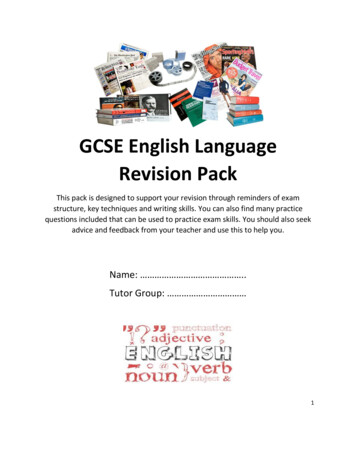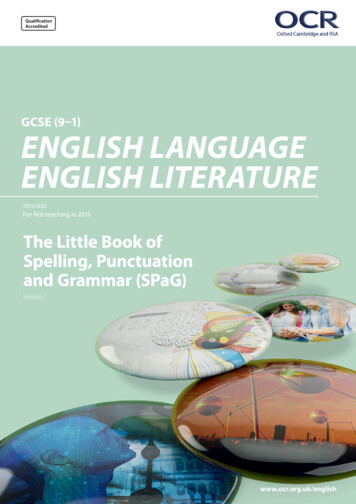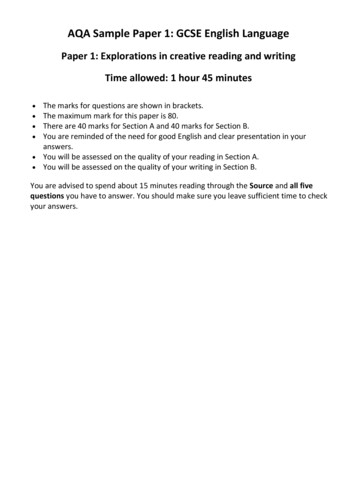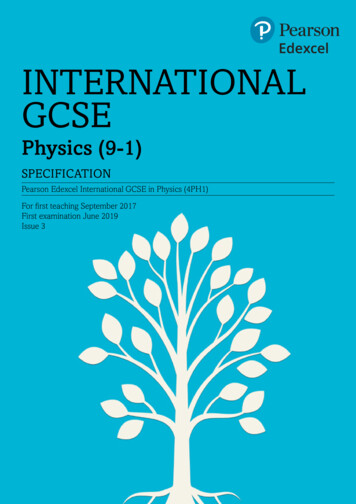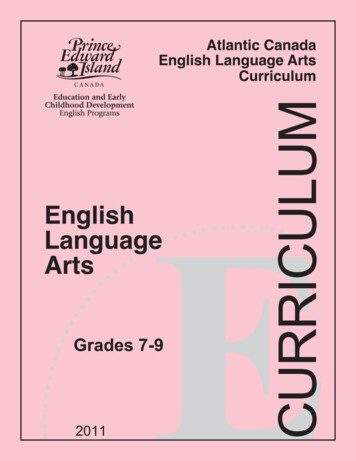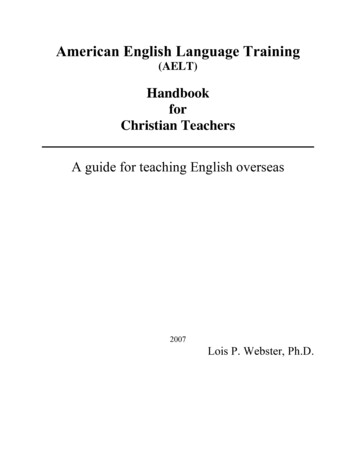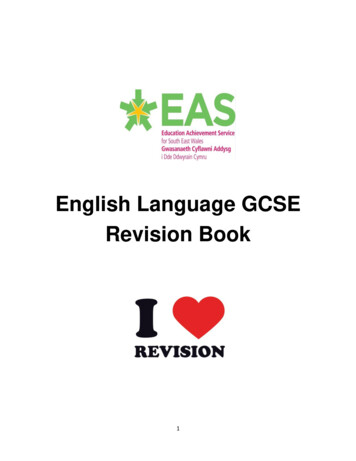
Transcription
English Language GCSERevision Book1
When are my English Language exams?Unit 1: non examination assessment: Groupdiscussion:Individual researched contribution:dates to be added by schoolUnit 2 exam: 6th June amUnit 3 exam: 12th June amAcknowledgementsBryn Hafren English FacultyWhere texts have been found on the internet, the website address has been given.Some content included is from: Navigating KS4 (written by CSCJES and EASJES)WJEC English Language Teachers’ Guide chers-guide-teaching-from-2015-e.pdf?language id 1)Resources created for the WJEC by Aberystwyth University aspx?rIid 691 and spx?rIid 690)2
What does English Language involve?Unit 1 Non Examination AssessmentOracy 20% 2 hoursTask 1 (10%) – Individual PresentationResearch a theme and give a presentation to the class.The presentation should last between 5 – 7 minutes including questions.Themes:WalesLeisureThe World of WorkThe World of Science/TechnologyCitizenshipTask 2 (10%) – Responding and InteractingOne group discussion based on the pre-published resources.The discussion should last for about 10 minutes per groupUnit 2 Exam 40% 2 hoursReading and Writing Description, Narration and ExpositionSection A (20%) – Reading (40 marks)Answer questions on different extracts.There will be at least three texts, could be up to five or six.Editing task focusing on understanding short texts (2.5% of qualification total).Section B (20%) – Writing (40 marks)One writing task from a choice of two: description (describe a moment in time or a travelogue),narration (story) or exposition (discursive essay).One proofreading task focusing on writing accurately (2.5% of qualification total).20 marks for this section will be awarded for content (meaning, purpose, readers and structure) and15 marks for writing accurately (language, grammar, punctuation and spelling).3
Unit 3 Exam 40% 2 hours Reading and WritingArgumentation, Persuasion and InstructionSection A (20%) Reading (1 Hour)Answer questions on different extracts.There will be at least three texts, could be up to five or sixSection B (20%) Writing (1 Hour)Two writing tasks (Letter/article/speech/review etc.)No choice.Linked thematically to Section A.10 10 for each taskHalf of the marks for this section will be awarded for content (meaning, purpose, readers andstructure) and the other half for writing accurately (language, grammar, punctuation and spelling).4
ContentsPage numberDatesWhat does English Language involveMaking a revision planWhat does revision look like?PunctuationParagraphs and spellingVarying words to open sentences and sequence ideasHomophone checkBetter ways to say ‘shows’ and ‘effectiveSkills and suggested resourcesSkills ladderIntroduction: Question TypesReading strategiesUnit 2 and 3 reading: Multiple choiceUnit 2 and 3 reading: Word /phrase meaningUnit 2 and 3 reading: Text purposeUnit 2 and 3 reading: ExplainUnit 2 and 3 reading: Analysis of writer’s techniqueUnit 2 and 3 reading: Evaluation / reflectionUnit 2 and 3 reading: Summary questionsUnit 2 and 3 reading: Synthesis questionsUnit 2 and 3 reading: Comparison questionsEditingProofreadingVocabulary practiceWords to describe toneWriting assessment criteriaWritingUnit 3 Writing: LetterUnit 3 Writing: SpeechUnit 3 Writing: ArticleUnit 2 Writing: Narrative writingUnit 3 Writing: ReportUnit 2 Writing: Descriptive writingGive your writing some flairExposition - questionsArgumentation – questionsPersuasion - questionsRecap on basic 5464748495o515253545556585960Red, Amber.Green
Making a Revision PlanCreate a Revision TimetableYou should start revising at least a couple of months before your exams are due to start. Do be realistic about the goals you set in the time you have available, and remember you need to allow forbreaks.Balance your subjectsAllocate topics to days, and make sure you have enough time for everything you want to revise. Balance the time you have available between your various courses. Do not neglect courses that you findparticularly easy or difficult.Identify key topicsFor each course, identify which topics to revise. At the very least, you should cover twice as manytopics as the number of questions you need to answer (e.g. 6 topics for a 3 essay exam). Select topics based on: Teacher guidanceThe content of the coursePast examination papersYour own interests and abilitiesArrange your revision materialYou will have your own notes from books and essays with your teacher's feedback, as well as anyhandouts and other photocopies and references. You will also need textbooks, past exam papers etc.Arrange to have everything you need well in advance.6
What does revision look like?Research suggests that the most effective way to revise is by spreading out revision over time and bycompleting practice tests.Self explanation – explaining the steps taken to answer a question or the success criteria for a task isalso very effective.You might work with a study partner and ‘teach’ them how to answer questions.You might make revision ‘how to videos’ on specific question types (Explain Everything, Snitch.)Record your success criteria / writing layout on a mobile phone / tablet and play back when you aredoing something else.Summarise success criteria for various reading questions.Summarise formats for different types of writingWork with a partner and teach one another the success criteria for different question types.Complete practice papers / questions - electronic and paper formComplete proof reading tasksComplete editing tasksShort burst tasks using revision guides: CGP (Spelling, punctuation and grammar packs for GCSE)Examine modelled answers for D/C and A/A*Learn key words or phrases for responsesUse spider diagrams or mind mapsMake revision cardsUse mnemonics to remember informationUseful websites:BBC Bitesize7
PunctuationFull stop.Indicates that a sentence has finished.Comma,Shows a slight pause in a sentence, separates clauses in acomplex sentence and items in a list.Questionmark?Goes at the end of a question instead of a full stop.Exclamation!Goes at the end of a dramatic sentence instead of a full stop toshow surprise or shock. Only one is required at the end of asentence if you are using it.Apostrophe‘Shows that letter(s) have been left out or indicates possession.Speechmarks“”Indicates direct speech - a character is talking. Remember tostart a new line for a new speaker.markQuote marksWhen writing non-fiction texts, words inside quotation marks areones you have taken from another source.Colon:Introduces a list, a statement or a quote in a sentence.Semicolon;Separates two clauses that are related and of equal importance.Dash-Separates extra information from the main clause by holdingwords apart.Used as a linking device in a sentence (e.g. 1914-1918).Can be used in dialogue when a speaker is interrupted.Brackets()They separate extra information from the main clause and canbe used like dashes to hold words apart.Ellipsis To show a passage of time, to hook the reader and createsuspense.Used in speech when the speaker does not finish their sentence.Also used when quoting in an essay to skip over irrelevantevidence.Hyphen-Used to divide, combine and join words. Used to createcompound adjectives (top-class) and for all compound numbersfrom twenty-one to ninety-nine.Singleinvertedcommas‘’The titles of books, poems, movies, plays, games and televisionshows should be placed in single inverted commas.8
ParagraphsI understand and can use the TIPTOP rule.You move onto a new paragraph when you change:Time: hours later, days later - even years later!Place: moving from one location to another.Topic: when the focus of your writing changes.Person: when you focus on a different person or when a new person speaks.To start a new paragraph, go to the next line and indent your first word. Do not skip awhole line.Spelling Sound out the word.Think about how it looks.Think about a similar word.Is there a memory sentence for the word? Big elephants cannot always use small exits. Are there words you recognise within the word? There is a ‘lie’ in ‘believe’. Find the word, check: the key words list, the classroom display, your own word bank, a dictionary or spell checker. Ask a friend or teacher. To learn it: look, cover, write & check. Once you’ve solved it add the correct spelling to your own word bank.9
I can vary the words I use to open sentences and sequence ideas10
Homophone checkHave – means to own or experience something.Of – expresses the relationship between a part and a whole.Never use ‘of’ in place of ‘have’.Your is in relation to someone the speaker is addressing.Your dog has run away.You’re is short for you are.You’re always chasing your dog.To - indicates intention, direction or status.I am going to the shop.Two – is the number ‘2’.There are two owls in the tree.Too - indicates something extreme or in addition to.There are too many owls.Can I come too?There shows position or indicates something.Your seat is over there.There are five boys in the class.Their shows that ‘they’ own somethingTheir blazers are navy.They’re is short for they are.They’re revising every day.11
Better ways to say tellsilluminatesunveilsillustratesBetter ways to say l12
How can you hone your writing skills? Here aresome useful websites to help you:Red,Amber,GreenVarying sentence structure (RELIC)https://www.youtube.com/watch?v czXZD-fhg7M&feature shareSkillswise: Is this is compound sentence: -is-this-acompound-sentenceApostrophes for omission and possessionVery basic resources designed for KS2 but they teach the rules and test understanding:apostrophe for possession: 22-de0d-4394-90b29cb44d2b286e/enapostrophe for omission: -d442f6fc80e1/enApostrophes for contraction and possessionSkillswise: -beat-the-clock-apostrophesWhen to use a comma and when to use a full stopApostrophes for omission and possessionVery basic resources designed for KS2 but they teach the rules and test understanding:apostrophe for possession: 22-de0d-4394-90b29cb44d2b286e/enapostrophe for omission: -d442f6fc80e1/enApostrophes for contraction and possessionSkillswise: -beat-the-clock-apostrophesHow can you hone your reading skills? Here are someuseful websites to help you:Super short stories that will take you just minutes to t-story-read n 4220181.htmlReading exercises with 1-ela-math-science-worksheets.htm#section-1For learners of English, but there are some useful exercises and you can change the level tomake it /skills/reading-skills-practiceBook agers/Daily comprehension sion.php?45513
Reading Skills ExplainedReading SkillRetrieveExplanationNavigating a text to locate and retrieve one (or more) distinct piece of information.ExplainGiving reasons for why something has occurred; explaining details of a process orconnections.Capturing the main ideas of a text in a shorter way using own ing multiple elements, often from different areas, into something new(A B C D).Reasoning as to the effect or meaning of words / phrases / texts.InferExploring similarities and/or differences of information, presentation, point of view,etc.Exploring what is suggested by words, phrases and images.EvaluateProviding a critical, detached response that includes overview.14
Introduction: Question TypesThroughout your examination you will be asked a series of different questiontypes on various texts that you will have to read. You will be very familiarwith each of the question types. There will be up to five or six text on eachpaper so you must have the stamina to keep going.The resource materials and the questions will be in different books so thatyou can have them side by side to refer back and forth from the question tothe resource materials.Make sure that you are looking at the correct text for each of the questionsas it is easy to get confused.Make sure that you keep going and attempt every question – be resilient!Timing will be difficult to judge. We know that there are 40 marks availablefor the reading sections so aim to spend 1 minute per mark available foreach of the questions. So for example, spend ten minutes on a ten markquestion and one minute on a one mark question. Don’t get to caught upand spend too long on the shorter one mark questions as you will not havetime to complete the higher tariff questions. You will also have ten minutesreading time and ten minutes to check your answers.Read the questions carefully, identify how many marks are available andhighlight key words in the question. Find the corresponding text and markoff the section that you need to focus on for theanswer. Actively readthe text using a highlighter to highlight any key words / quotes that answerthe question. For longer answers, keep quotations short and briefly annotatewhat they imply. Make sure that you use key words from the questionthroughout your answer. Make sure that you track through the text carefullyas you make your point.15
16
Unit 2 and 3 reading: Multiple Choice Questions You will be asked approximately three multiple choice questions on both Units 2 and 3. Multiple choice questions can test a range of different reading skills and you will be given between four or five possible answers to choose from. Multiple choice questions can be used to test a number of different skills including: Locating correct information Deducing word meaning Using verbal reasoning skills Understanding of texts (in context) Purpose of textYou should always locate the correct text/area of a text before attempting to answer a multiplechoice question. Once you have done this, if the information is contained within the text, you must,as a minimum, read the sentence in which the information can be found so you are able to contextualise what you have read and detect any possible clues that may help when answering a question.Sometimes you may pick up on the correct answer almost immediately and may only need tohave a cursory glance at the options included as answers for the question. Sometimes you mayhave to work through all of the possible answers and eliminate those which are not correct.Possible Question Types: Only one of the following is a fact about woodlands, which one is it? What does the following word mean ? How many people have been known to travel by train at any given time in the UK? What is the purpose of this text? Which category of people cycle to work most frequently?17
Strategies for answering multiple choice questionsRead the directions.Are you being asked to find the best response or a correct response?Answer each question in your head first before you look at the possibleanswers.Read the stem and all of the choices before selecting your answer. Ifyou aren't sure of the correct answer:Eliminate alternatives that are absurd, silly, or obviously incorrect.Cross off answers that are clearly not correct.Make sure the stem and the choice you've chosen agreegrammatically.Choose the alternative that is most inclusive.The longest choice is usually correct. It contains elaborationsnecessary to make it correct.The correct choice will usually contain relative qualifiers such asusually, generally, sometimes, often, etc. These words allow forexceptions.The correct choice will usually not include absolute qualifiers such asalways, never, at no time, etc. These words do not allow forexceptions.Be alert for choices that are identical (they are usually both incorrect)or opposite (often one of them will be the correct choice).Be careful when asked which is not true or all of the following applyexcept. These are asking you to pick an incorrect answer. If there is nopenalty, guess if you don't know the answer! You have a 20-25%chance of choosing the correct response on most multiple choicequestions18
Read the following text:RSPCA Key Information We have approximately 340 RSPCA inspectors, 50 animal welfare officers(AWOs) and 88 animal collection officers (ACOs) working to prevent cruelty and promote kindness to animals in England and Wales.Our inspectors now investigate more than 140,000 complaints of cruelty and neglect every year.In 2007, the Animal Welfare Act became law in England, shortly after it was implemented in Wales. Described as the single most important piece of animal welfarelegislation for nearly 100 years, the Act places a legal obligation on owners andkeepers of animals to care for them properly.We have a network of 162 RSPCA branches around England and Wales, and wework with many animal welfare organisations abroad through our international team. During 2015 the RSPCA. rescued and collected 118,994 animals found new homes for 47,651 animals microchipped 51,337 animals neutered 68,298 animals treated 153,605 animals investigated 143,004 cruelty complaints secured 1,781 convictions by private prosecution to protect animals against thosewho break the lawsTaken from http://media.rspca.org.uk/media/factsHow many RSPCA branches are there around England and Wales? 340140, 000162118, 994This a locating correct information question. It’s prettysimple, really! How do you know which is the correctanswer? Use your scanning skills to search for a keyword/symbol. You could scan for each number offered inthe choices and check to what they refer. Or, you couldscan for the word branches. Don’t rush and move onwithout checking all of the information first.19
Unit 2 and 3 reading: Word /phrase meaningHow do you work out the meaning of a word you don’t know?Strategies CLUES from CONTEXTTRY OTHER WORDS (SYNONYMS)PREFIX/SUFFIXSOUNDS LIKEClues From ContextRead the whole sentence. How does the word fit in to that sentence? (context) What is the meaningof the sentence as a whole? Guess what the word might mean inside the sentence.Try Other Words (Synonyms)Try placing every word you are given into the sentence to see if it makes sense.The dog at the postman.barkedfoldedThe dog barked at the postman.The dog folded at the postman.The dog swallowed at the postman.The dog meowed at the postman.swallowedmeowedONLY THIS ONE MAKES SENSEPrefix/SuffixLook at the prefix or suffix added to the word. (set of letters added to the start or end of a word.)What does unhygienic mean?Hygienic cleanUn in front of a word means not’/the opposite of so unhygienic means the opposite of hygienic(clean). Therefore, unhygienic means dirty’.Sounds LikeThis one doesn’t always work but have a think if the word you are stuck onreminds you of another word you do know.What is emotive language?Emotive reminds me of the word emotion.Emotions are feelings so emotive language must be words that make you feel something.Emotion also reminds me of emoticons. I use emoticons and emojis on my phone to show peoplehow I am FEELING.20
What is meant by the word implemented in the text? put into effectachievedbecame lawfinalisedThis a deducing word meaning question. It’s a bit more complicated.First, ignore the choices and scan to find the word in the text. Are there any clues?Word in the questionIn 2007, the Animal Welfare Act became law in England, shortly after it was implemented in Wales.Clue phraseWhat do you think the word means, without looking at the choices? Were you right? Make sure byfollowing the next step:Try using the different choices instead of the word. Do they all make grammatical sense? If not,disregard them straightaway. Do those that are left make sense, meaning-wise? If not, get rid ofthem too!Be careful that you check it makes sense in this particular text. Often, the distractors (the wronganswers) are closely related to the word but they do not necessarily make sense in the text you’veread.What is meant by the word obligation in the text? rightdutydebtagreementWhat is meant by the word abroad in this text? travellingawayholidayoverseasWe’ve only really practised word meaning questions here. You could be asked about text purposeand other ideas in a multiple choice question. Just remember:21Beware Distractors!
Unit 2 and 3 reading: Text purposeYou will be asked to identify the purpose of a text using one of the following labels.PERSONAL: texts thatare intended to satisfyan individual’s personalinterests.For example:letters, fiction, diarystyle blogsPUBLIC: texts thatrelate to activities andconcerns of the largersociety.For example: publicnotices, news websitesOCCUPATIONAL:related to work.For example: jobadvertisement in anewspaper or onlineCan you determine which purpose best suits these texts?22EDUCATIONAL:usually designedspecifically for thepurpose of instruction.For example:text books, interactivelearning software).
Unit 2 and 3 reading: Explain questionsThis question tests the ability to refer to evidence within texts, to evaluate and reflect on the ways inwhich texts may be interpreted differently according to the perspective of the reader anddistinguishing between facts or evidence and opinions, bias and argument. An explain question asks you to make (an idea or situation) clear to someone by describing itin more detail or revealing relevant factsAn explain question asks you to give a reason so as to justify or excuse (an action or event)Example questions:1. Explain the relationship between . [1]This question tests the ability to interpret ideas and information.2. Use the text to explain what has happened to [2]This question tests the ability to refer to evidence within texts and use inference and deduction skillsto retrieve and analyse information.3. Explain how . [5]Explanations are all about ‘cause and effect’. It is therefore helpful to have the vocabulary to explainthese relationships:23
Question:TEXT D7. Explain how this payday loan company makes itself sound responsible and trustworthy. [5]Add the main points of the explanation to the table below and complete the second columns:Point from the textEffect / Consequence24
Unit 2 and 3 reading: Analysis of writer’s techniqueKey Points: You must ensure that they constantly refer to the question to make sure they remain on task.Every claim made should be supported by a reference to the text/textual evidence.Where relevant (and to access the top bands), you need to comment on effect of the writer’stechniques.Make sure that you track through the text.You should avoid using technical terminology instead of answering the question (e.g.alliteration makes me read on etc.) and commenting on short sentences.You should never allow yourselves to be driven by a devices spotting approach, instead youshould try to answer the question and refer to techniques that complement the points theymake.You should use: Point, Quotation, Analysis.You can comment on the following areas when referring to a writer’s techniques:Content – learners should look closely at what is said (facts, figures, examples, quotations etc.) and,if they can, explain and/or comment on these.Structure – learners should think about the way in which the writer has organised or structured theirpoints. They should think about the ‘steps’ in the argument, do they follow a logical sequence? Doesthe writer present the problems and then solutions? Do they structure their points to enable thereader to see a contrast or comparison?Language/Tone – learners should look for the key words and phrases (ensure quotations are clearbut not too long) that contribute to the overall effect of the text. They should try to comment on oranalyse the effect of the words/phrases they have selected while focusing on the question asked.When focusing on tone they may examine the overall tone created by individual words or an entiresection.Method – learners should try to identify the ways in which the writer is trying to achieve effects(comparison, scare tactics, putting a positive case, painting a picture of something, using anecdotesetc.)Pictures – learners often find it difficult to refer to pictures as they are unable to use quotations. Whencommenting on pictures they should say what is in them and what the effect is.25
Example Question: TEXT D UNIT 3 SAMs: ‘Health and Safety’TEXT D is a webpage entitled ‘How Safe is Flying?’.1. Pilots are professionals. Pilots strive to give you (the passenger) the smoothest flightpossible because that’s how they know they are doing a good job.2. Commercial pilots are thought to be boring people. Before Airlines hire a pilot, the pilotmust take rigorous psychological tests to ensure he/she is someone who is detailed orientedand takes little or no risks in life. Nice people, but boring :)3. Pilots often go a full career without ever experiencing an engine failure.4. Airplanes can fly safely to their destination if one engine fails. If flying on a two engineplane, one engine went out, the aircraft could fly with just one.5. If all engines were to stop at cruising height (35,000 feet) an aircraft can glide for 30 minutesbefore it lands on the ground. An aircraft has the ability to glide 120 miles because all thecontrols work as if the engines were still going.6. No flying bird can stop a jet engine. During the testing phase, testers throw whole deadchickens through the jet engines to ensure they maintain full functionality.A8. How does this text try to persuade the reader that flying is safe? [5]Refer to the language used by the writer to influence the reader.This question tests the ability to use inference and deduction skills to retrieve and analyse informationfrom written texts and reflect on the ways in which texts may be interpreted.26
Unit 2 and 3 reading: Evaluate and reflectTo evaluate / evaluation means e.g. to judge or assess the worth of; to appraise.You might need to evaluate what others have written (writer’s viewpoint).You might have to evaluate what you think about what you’ve read (your personal viewpoint). Or youmight have to evaluate how a writer has achieved a particular effect.Key Points: As part of the reading assessment, you will be asked to critically evaluate a nonfiction text. Every personal judgement should be supported by appropriate textual references.Your responses to evaluation questions will require a considered personal judgement, which isinformed and evidenced through apt references to the text. At higher levels, responses will alsorequire a degree of critical overview and summation.The following are question types that may introduce the need for evaluation skills: What do you think and feel about a subject? What do you think and feel about a writer’s views? What does the writer think about horse-riding? How far do you agree with him?These types of questions often have how in them and call for you to use evidence from the text tosupport your points.How does the writer feel about Britain’s performance at Rio 2016 and how do you know? [5]This question tests your ability to interpret meaning, ideas and information in challenging writing and torefer to evidence within texts.Start with providing an overview. What’s the writer’s general feeling? Overall, the writer is very happyabout Britain’s performance at Rio 2016.Then, track though the extract. You’ll need to widen your vocabulary and use different words to illustrate hisfeelings. With each different feeling, you’ll have to provide a piece of evidence from the text and explainhow it helped you decide how he’s feeling. Some evidence you might like to use is highlighted. Perhapsyou can practise writing this up into a paragraph?27
Example Question:Let the Rio Olympics be a lesson to all those who doubt Britain's greatnessIt was fitting that an extraordinary fortnight for the British Olympic team in Rio de Janeiro should haveculminated in another gold medal for Mo Farah, the country’s greatest ever long-distance runner. In manyways Farah sums up what Britain has become: a vibrant nation of many ethnicities, backgrounds and faithsunited by a desire to be the best in the world.Just 20 years ago, when the Olympic team won a solitary gold medal in Atlanta, this was considered anational disgrace, and rightly so.To produce champions in events as diverse as dressage and canoe sprinting shows a country where unsungand dedicated individuals in many walks of life are sacrificing almost every waking hour in pursuit of theirone shot at glory. It has been truly inspirational.From t-britains/IT’S A MAD, MAD WORLDWelcome to Mad Sunday on the Isle of Man. Yesterday was the serious Formula 1 stuff, but today isfor the crazy amateurs. They will be at it soon after dawn and the TT circuit will, as usual, be riddenby any wildcat on two wheels who fancies his cha
Complete practice papers / questions - electronic and paper form Complete proof reading tasks Complete editing tasks Short burst tasks using revision guides: CGP (Spelling, punctuation and grammar packs for GCSE) Examine modelled answers for D/C and A/A* Learn key words or phrases for respo
